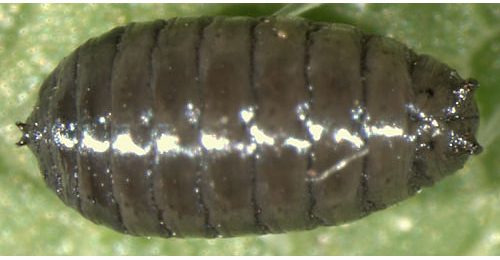|
||||||
|
Phytomyza
heracleana Hering, 1937 Phytomyza
heracleana Hering, 1937c. Blattminen Mittel- Nordeuropas
Lief 5, 6: 582 |
||||||||||||||||||||||||||||||||||||||||||||||||||||||||||||||||||||||||||||||||||||||||||||||||||||||||||||||||||||||||||||||||||||||
|
Leaf-miner: A regular greenish inter-parenchymal blotch mine, frequently delimited by two veins, appearing somewhat mottled as a result of small deeper areas of feeding through the upper parenchyma (Spencer, 1972b: 78 (fig. 259); Spencer, 1976: 428, 429 (fig. 748). The mine starts with a quite inconspicuous lower-surface corridor that soon changes into an extensive interparenchymatous blotch. The upper cell layer of the palisade parenchyma is eaten away in many places, giving the mine in transparency a perforated appearance. Fresh mines are pale green, later they turn brown; they give the leaves a strikingly diseased impression. Feeding lines absent, frass grains strikingly few. Larvae solitary. Pupation outside the mine, exit slit in lower epidermis (Bladmineerders van Europa). Forms a blotch mine between two veins, having a characteristic sieve-like appearance (where the larva has fed through the upper parenchyma). Pupation outside the mine. (British leafminers). Larva: The larvae of flies are leg-less maggots without a head capsule (see examples). They never have thoracic or abdominal legs. They do not have chewing mouthparts, although they do have a characteristic cephalo-pharyngeal skeleton (see examples), usually visible internally through the body wall. The larva is described Griffiths (1973c), de Meijere (1937) and illustrated in Bladmineerders van Europa. Puparium: The puparia of flies are formed within the hardened last larval skin or puparium and as a result sheaths enclosing head appendages, wings and legs are not visible externally (see examples). Black; posterior spiracles each with 14-20 bulbs (Spencer, 1976: 428). The puparium is illustrated in Bladmineerders van Europa.
Comments: Hering (1957a) includes Angelica and Seseli as host plants, but Griffiths (1973c) and Spencer (1973a) regard these records as doubtful. The species can only be distinguished from related species by characters of the male genitalia. Hosts in Great Britain and Ireland:
Hosts elsewhere:
Time of year - mines: June-August. Time of year - adults: Currently unknown. Distribution in Great Britain and Ireland: Widespread in Britain including Cornwall (Portleven), Derby (Miller's Dale), Denbighshire (Cefn-y-bedd), Perth (Killin) (Spencer, 1972b: 80), Inner Hebrides (Isle of Coll) (Bland, 1992), Warwickshire (Astley) (Robbins, 1991: 67); Cambridgeshire, Derbyshire, East Glooucestershire, East Suffolk, Easterness, Glamorgan, Main Argyll, Mid-west Yorkshire, Nottinghamshire, Shropshire, South Lancashire, South-east Yorkshire and South-west Yorkshire (NBN Atlas). Also recorded in the Republic of Ireland: Co. Clare (Burren), Co. Cork (Bantry) and Co. Kilkenny (Kilkenny) (Spencer, 1972b: 80). Distribution elsewhere: Widespread in continental Europe including Denmark, Norway, Sweden (Spencer, 1976: 428), The Netherlands (Bladmineerders van Europa), Germany (Spencer, 1976: 570), Austria, Bulgaria, Czech Republic, French mainland, Hungary, Italian mainland, Lithuania and Poland (Fauna Europaea). NBN Atlas links to known host species:
British and Irish Parasitoids in Britain and elsewhere:
|
| Last updated 10-Jul-2019 Brian Pitkin | ||

